#for non-finnish followers:
Explore tagged Tumblr posts
Note
Reissumies ja Koskenlaskija, siis mindblown 🤯 vähän sellasta väinölinnamaista henkeä myös dialogissa. En ehkä kestä sitä neroutta.
VÄINÖLINNAMAISTA, sitä se tosiaan on! Aivan huikeaa dialogia. Ja kaikki ne maalaisromanttiset kesämaisemat ja -tunnelmat, perinnehommat ym.! Melkein vois sanoa että joku ihme kansallistunne läikähteli tota lukiessa.
Siis mä en oo tainnut ikinä lukea suomeksi kuin pari jotain läpällä kirjoitettua ficciä niin tämä kyllä yllätti todella positiivisesti.
#en kehtaa tägätä kunnolla#for non-finnish followers:#we are gushing about a masterpiece of a fic featuring 'characters' from two finnish grocery brands#it sounds like crack and sort of is but it's also a beautifully written piece of fiction and study of finnish culture#not yr
3 notes
·
View notes
Text
käärijä drawing!!! because i have fallen in love with this man and i need to enforce my love for him onto everyone!!!!!!

can't believe the esc final was over a week ago, i am still INCREDIBLY bitter about the results. he should've won ughhhh i am exploding the jury in my mind💥💥💥💥 (p.s. tap the drawing for better quality if it's blurry 🥲)
#sorry to my followers for posting a non dr drawing! i hope nobody minds#käärijä#kaarija#jere pöyhönen#eurovision#esc23#idk what to tag this sorry i have no idea lol ive stared at so many käärijä posts but the tags aren't familiar enough in my mind yet#my art#anyway yeah i am in love with him<3<3<3♡♡💚💚💚💚💚 he is very special to me#cha cha cha#watched the livestream of his concert yesterday and i ughhhhhhh i love him#can i speak finnish? no. will that stop me from admiring him? of course not#do yourself a favour and listen to more of his songs than just cha cha cha though because all of his songs are so good !!!#if you are a follower of mine and have no idea what this is about i am sorry for your loss🥲 search finland eurovision final rn#<- (but not if you're photosensitive lol because. it is very flashy!!! as is the whole of eurovision)#im nervous to post this it's the first art im posting outside of dr but i hope people like it#anyway cha cha cha slays so hard#sorry for me going insane mode in these tags i just. i love him. i love him i love him i love him i love h
62 notes
·
View notes
Note
do u have any good nonfiction book recs??
Sorry, not really! I read books in Finnish by Finnish or Nordic writers and literally none of my favorites have been translated into English ahahahah </3
#well i do read in english but thats mostly comics and fiction. non fiction is kinda tricky in english for me still so#but if my finnish followers are interested my non fiction favs are Tyttö joka sai kaulapannan#keskiajan hirviöt (Miikka Tamminen) and Jänis Maailman Myyteissä Ja Tarinoissa and im currently reading the new biography of Vampira!#but yeah sorry i really cannot help you with this one :(
2 notes
·
View notes
Text
those finnish smurf parody songs motivate me so mucj that i think i will colour an another art piece again oh yeah ooh ooh yea yea (this is my fav, it slaps)
#just talkin'!#like CMON!!!!!smurf music is so good#i'm finnish you're not i get them you don't /j (targeted at my non-finn followers🔥)
5 notes
·
View notes
Text
välillä kun mulla on huono päivä niin mä vaan mietin sitä miten mun vanhempien kotipaikkakunnalta löydetty glory hole/katselureikä oli niin iso juttu että siitä tehtiin sillon sivun kokonen juttu paikallislehteen
#siis alkaa naurattaa samantien#mulla on siitä jutusta kuva jossain…täytyyki etsii se#gotta love pikkupaikkakunnat#sorry @ all my non finnish followers who just had to see the word gl*ryhole with no context lol#suomitumppu
3 notes
·
View notes
Note
would you say lehky prefers arsi or artturi 👀
to be honest, i'm not sure haha. in interviews and things, teammates really only refer to him as Artturi. My understanding (which could be wayyy off) is that Arsi is used more either while speaking Finnish/by Finnish people? I'm not sure if it's just a colloquial/linguistic thing or a familial/friend thing? Maybe both? Like Mikko has definitely used it (just like Artturi uses Rane when talking about Mikko, but I think I've only ever heard him use it in Finnish interviews? And no other teammate calls Mikko that as far as I'm aware).
If there are more knowledgable people out there that want to add to this, feel free too!
#sorry im not much help lol#when im writing lehky i tend to use artturi more#mostly cause im just not 100% sure haha#but idk if this question was from a writing perspective#or just a general perspective#if it was a writing perspective i don't really think there's a wrong answer tbh#anyways i know i have some finnish followers so perhaps they can add some clarity#or non-finnish followers who just know more than me haha#answered#anon
3 notes
·
View notes
Text
Traduzione alla cazzo.
Every time I see my mutuals post in their native tongue that I don't understand I'm like yes 🥰 that's language babes 💖
#a special thought to all my non-italian mutuals who get my analysis of tokyo mew mew#and shoutout to that finnish person i follow who fills my dashboard with what i think are rants on their bad politicians
67K notes
·
View notes
Text

When Finland’s Käärijä took the stage at this year’s Eurovision, a star was instantly, explosively born. With an outrageous energy, infectious presence and that oh-so-catchy hook, the Vantaa-based rapper may not have won the contest but he certainly snatched the hearts of those in his home country and beyond. We ask Käärijä the million dollar question: what next?
[full article under the cut]
Last May, a peculiar frenzy engulfed Finland. Virtually all green foods – cucumbers, especially – were sold out from stores. Buildings across the land were bathed in vivid green lights. Social media brimmed with green-themed parties, while data obtained by Swedish fintech company Klarna showed a 570 per cent increase in the online sales of neon green shirts.
This phenomenon was all thanks to Käärijä, the rapper who represented Finland in the 2023 Eurovision Song Contest. His now-infamous, blazing green puff sleeve bolero – dreamt up by Finnish broadcasting company Yle’s costume design team and which he dons when performing the smash hit track ‘Cha Cha Cha’ – had taken on a life of its own, the lush hue uniting the entire nation amid the competition. “It was incredible to see it happen and so cool being part of it,” Käärijä says. “It wasn’t planned at all – it was the people who created the commotion. I’ll definitely never forget it.”
When we speak over Zoom, Käärijä, whose real name is Jere Pöyhönen, is lounging in his minimal apartment in Vantaa, a city just outside Helsinki. He appears on my screen shirtless, a chunky gold chain dangling on his neck. On his head sits a pastel turquoise cap adorned with little cat ears. As he gestures with his hands, I spot flashes of poison green nail varnish. Pöyhönen’s chosen attire, or lack thereof, is extremely fitting – he typically performs bare-chested (“It gets so hot during my gigs”) and his Instagram handle is @paidatonriehuja, or ‘shirtless rascal’.
Hot off a performance in western Finland, the 29-year-old is enjoying his first days off in a while. It’s been a sweltering summer of non-stop touring, with fans flocking to festivals and concerts nationwide to see his explosive live show. Things are not winding down either, with Käärijä heading off on his first-ever European tour this month. Some of these shows sold out in mere minutes, an indication of his immense international following. “It’s so exciting; I’m definitely jumping into a new territory with that tour,” Pöyhönen says. “But I don’t have any expectations – I’m just going to let everything happen organically rather than stressing about it.”
Although he created one of this year’s buzziest songs, the guy on my screen is humble and, save for his look, almost un assuming. I remark on the stark contrast to his fiery and flamboyant stage presence. “Through Käärijä, I get to channel all the craziness, quirkiness and hyperactivity I’ve had since I was a child,” Pöyhönen says, describing himself offstage as “just this ordinary dude”. Without delving into further details, he tells me that the name Käärijä (translating roughly to moneymaker) stems from a history with gambling. Despite the darkness of its origin, he notes that the moniker is to be taken with a grain of salt.
While it might seem like Käärijä exploded into the public consciousness from obscurity, Pöyhönen has a long journey in music behind him. Born in Helsinki but having spent most of his youth in Vantaa, he started dabbling in the medium at just three years old. Coming from a musical family (“My dad and big brother both play the guitar”), jamming sessions were commonplace in the Pöyhönen household, his instrument of choice being the drums. “I was playing with pots and spoons before I got a set of those plastic kids’ drums,” he says. “When we moved to a bigger house, we built a band room downstairs where me and my brother spent a lot of time practising.”
At that time, rap music hadn’t yet entered Pöyhönen’s life; he was strictly a self-described “metal guy”. His older brother had instilled in him a love for the genre, particularly metal icons Rammstein. Upon starting high school, his musical taste broadened and he began listening to Eminem and popular Finnish rap groups Fintelligens and JVG. “Me and my friends were filming our own music videos to old rap songs, learning the words by heart,” Pöyhönen says. “It [making rap music] pretty much started as this humour thing I did with my mates.”
Encouraged by his loved ones, Pöyhönen began writing his own songs, still playing it for laughs. Turned out he had a knack for it. “Since I was little, I’ve been an avid storyteller – my imagination ran a little wilder than the rest of the kids’ at my school,” he says. “So when I started making music, I didn’t even need inspiration; I was able to whip up the lyrics from my head.”
But then, at 15, an unexpected turning point came by way of a severe sudden illness. Rushed to the hospital with ulcerative colitis, a chronic inflammatory bowel disease, Pöyhönen underwent emergency surgery to remove his colon. Had he not been treated immediately, the complications could have been fatal. “I was writing songs in the hospital – music became a source of strength for me,” he says. “I decided that if I make it through this, I’m going to give my all to music and be serious about it.”
After over a decade of hard work and countless hours in the studio, Käärijä released his first album, Fantastista (Fantastic), in 2020, but it would take three years for him to become a household name in Finland. After snapping up the top prize in Uuden Musiikin Kilpailu (the Finnish contest for new music) with his party anthem ‘Cha Cha Cha’, a song dedicated to a hedonistic night out fusing rap, electronic music and metal, he secured the coveted spot as his country’s entrant for the 2023 Eurovision, held in Liverpool. One of Pöyhönen’s craziest dreams had come true.
For Pöyhönen, Eurovision was “an amazing but immensely tough experience”. The event’s intense schedule and the little time carved out for practising surprised the artist. There was no room for errors or retakes once it was time for rehearsals. “They didn’t give much mercy,” he says. On the bright side, the long days filled with “lots of press conferences and waiting around” gave Pöyhönen a chance to get to know the other artists. “The group we had there was wonderful – there wasn’t a competitive atmosphere at all,” he says. One of the contestants he became especially close with was Sweden’s Loreen, with whom he exchanged numbers and promised to “meet up and talk about everything else but music”.
By the time the grand finale came, Käärijä’s explosive performance and infectious song had made him one of the favourites to win. Ultimately he came second, while Loreen nabbed first place. How did Pöyhönen handle the letdown? “It was a huge disappointment, but in the end, the feeling didn’t last long,” he says. “When I thought about how far I’d gotten, the incredible journey it was and all the new friends I made, I realised that these things are far more meaningful than winning.” Plus, he still achieved something major: ‘Cha Cha Cha’ made history as the first ever Finnish song to reach Spotify’s global most-listened charts. The track’s reach proved to Pöyhönen that language doesn’t matter; it’s all about creating a singular, infectious sound: “The mouth is just as much of an instrument as the piano or the guitar is,” he says.
Having made history, I ask Pöyhönen if he felt any pressure after the Eurovision bubble had burst. “Of course there are the thoughts of ‘what now?’ and ‘is this going to be it, will anyone be interested anymore next year?’ – I’m aware that the hype won’t last forever,” he says. “But I’m onto creating the next thing, trying not to feel any pressure for future releases. I haven’t done that before, so why would I do that now?”
Pöyhönen hints at a new album dropping sometime next year, but in the meantime, he’s enjoying the attention – including his Vogue Scandinavia debut. Shot at the extraordinary home of the late interior architect Antti Nurmesniemi and his wife, textile artist Vuokko Nurmesniemi, we find the space where Pöyhönen and Käärijä meet, the quiet confidence mingling with that more-is-more persona.
And while Käärijä might develop as a character (“I want to show that he’s more than just a bolero chap”), he’s adamant that he will stay true to his music and keep singing in Finnish, despite the sudden international attention. “In the end, I’m doing this for myself,” he says. “Also, why change something that works?”
Photographer: Karoliina Bärlund Stylist: Sanna Silander Talent: Käärijä Hair Stylist and Makeup Artist: Neea Kuurne Photographer Assistant: Milja Laakso Stylist Assistant: Nelli Korhonen
559 notes
·
View notes
Text

Background: During adolescence, bullying often has a sexual content. Involvement in bullying as a bully, victim or both has been associated with a range of negative health outcomes. Transgender youth appear to face elevated rates of bullying in comparison to their mainstream peers. However, the involvement of transgender youth as perpetrators of bullying remains unclear in the recent literature. Objective: The aim of this study was to compare involvement in bullying between transgender and mainstream youth and among middle and late adolescents in a general population sample. Methods: Our study included 139,829 students in total, divided between a comprehensive school and an upper secondary education sample. Associations between gender identity and involvement in bullying were first studied using cross-tabulations with chi-square statistics. Logistic regression was used to study multivariate associations. Gender identity was used as the independent variable, with cisgender as the reference category. Subjection to and perpetration of bullying were entered each in turn as the dependent variable. Demographic factors, family characteristics, internalizing symptoms, externalizing behaviors, and involvement in bullying in the other role were added as confounding factors. Odds ratios (OR) with 95% confidence intervals (95% CI) are given. The limit for statistical significance was set at p < 0.001. Results: Both experiences of being bullied and perpetrating bullying were more commonly reported by transgender youth than by cisgender youth. Among transgender youth, all involvement in bullying was more commonly reported by non-binary youth than those identifying with the opposite sex. Logistic regression revealed that non-binary identity was most strongly associated with involvement in bullying, followed by opposite sex identity and cisgender identity. Transgender identities were also more strongly associated with perpetration of bullying than subjection to bullying.
--
Secondly, we found that transgender identity was generally associated with perpetrating bullying and that the association was stronger than that of transgender identity and being bullied. To the best of our knowledge, past research has not examined perpetration of bullying among gender minority youth, thus rendering comparisons to prior research impossible. In a study by Dank et al. (2014), however, it was reported that the few transgender young people in their study were the ones most likely to perpetrate dating violence among their sample.
--
Thirdly, non-binary identity was more strongly associated with involvement in bullying than opposite sex identity. Past research has found elevated rates of being subjected to bullying among youth (Lowry et al., 2020; van Beusekom et al., 2020) and transgender youth (Gower et al., 2018) who perceive themselves as more gender non-conforming (i.e., masculine females or feminine males) than youth with no such perception. Non-binary identifying youth particularly may display gender expression that does not conform to either masculine or feminine roles, and this may make them vulnerable to being bullied either due to simply being different from the mainstream, or as a result of heterosexist control. We found, however, that not only being bullied but also engaging in bullying was even more common among non-binary (perception of gender conforms to both or neither sex or it varies) than among opposite sex identifying youth.
==
"Non-binary" is just a new way to bully other people.
Trying to make people refer to you in stupid, language defying ways, like "schglie/schglem," at the threat of being called a bigot, when you're a completely average man or woman, is the modern day equivalent of making the kids in the playground bow and call you "the god of the jungle gym" at the threat of being beaten up, when you can't actually do that flip from hanging by your knees into a standing position.
When, unlike the playground, society has given you the power to actually carry out that threat, you're not "marginalized," you're the ruling class. (What's that "power plus" arithmetic again?)
Whenever you enter the room, people tense up. And you love it. It's the whole point. Gay and transsexual people just want to blend in, but "nonbinary" is about the opposite. Everybody pays attention to you and you steal the oxygen out of the room. You say it's about "being kind," but you and everyone else knows what you are, which means it's really about being in control, but from a false position of vulnerability.
So it's no wonder it attracts narcissists and bullies. Especially when it's an effort-free way of being celebrated for a month - and on and off the rest of the year for an endless parade of "awareness" days - for being completely unremarkable and average.
Not being a tired stereotype is not an achievement, least of all one that needs to be celebrated.
#non binary#nonbinary#narcissism#narcissistic personality disorder#bullying#trans violence#gender ideology#queer theory#gender identity#religion is a mental illness#authoritarianism
966 notes
·
View notes
Text
Tamil Linguistics thread (bc nobody cares but me)
but really, if you are interested in linguistics at all, give this post a read, because this shit really blew my mind ...
have been reading the following paper: https://ccat.sas.upenn.edu/~haroldfs/public/h_sch_9a.pdf
"The Tamil Case System" (2003) written by Harold F. Schiffman, Professor Emeritus of Dravidian Linguistics and Culture, University of Pennsylvania
Tamil is one of the oldest continuously-spoken languages in the world, dating back to at least 500 BCE, with nearly 80 million native speakers in South India and elsewhere, and possessed of several interesting characteristics:
a non-Indo-European language family (the Dravidian languages, which include other languages in South India - Malayalam being the most closely related major language - and one in Pakistan)
through the above, speculative ties to the Indus Valley Civilization, one of the first major human civilizations (you can read more about that here)
an agglutinative language, similar to German and others (so while German has Unabhängigkeitserklärungen, and Finnish has istahtaisinkohankaan, in Tamil you can say pōkamuṭiyātavarkaḷukkāka - "for the sake of those who cannot go")
an exclusively head-final language, like Japanese - the main element of a sentence always coming at the end.
a high degree of diglossia between its spoken variant (ST) and formal/literary variant (LT)
cool retroflex consonants (including the retroflex plosives ʈ and ɖ) and a variety of liquid consonants (three L's, two R's)
and a complex case system, similar to Latin, Finnish, or Russian. German has 4 cases, Russian has at least 6, Latin has 6-7, Finnish has 15, and Tamil has... well, that's the focus of Dr. Schiffman's paper.
per most scholars, Tamil has 7-8 cases - coincidentally the same number as Sanskrit. The French wikipedia page for "Tamoul" has 7:
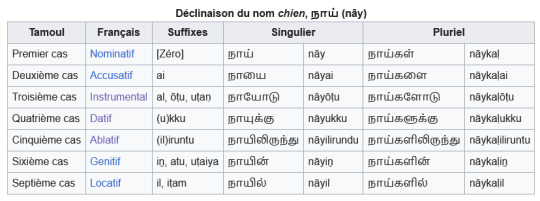
Dr. Schiffman quotes another scholar (Arden 1942) giving 8 cases for modern LT, as in common in "native and missionary grammars", i.e. those written by native Tamil speakers or Christian missionaries. It's the list from above, plus the Vocative case (which is used to address people, think of the KJV Bible's O ye of little faith! for an English vocative)
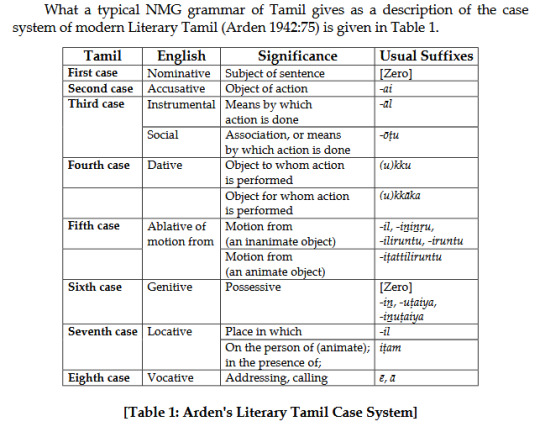
... but hold on, the English wiki for "Tamil grammar" has 10 cases:

OK, so each page adds a few more. But hold on, why are there multiple suffix entries for each case? Why would you use -otu vs. -utan, or -il vs -ininru vs -ilirintu? How many cases are there actually?
Dr. Schiffman explains why it isn't that easy:
The problem with such a rigid classification is that it fails in a number of important ways ... it is neither an accurate description of the number and shape of the morphemes involved in the system, nor of the syntactic behavior of those morphemes ... It is based on an assumption that there is a clear and unerring way to distinguish between case and postpositional morphemes in the language, when in fact there is no clear distinction.
In other words, Tamil being an agglutinative language, you can stick a bunch of different sounds onto the end of a word, each shifting the meaning, and there is no clear way to call some of those sounds "cases" and other sounds "postpositions".
Schiffman asserts that this system of 7-8 cases was originally developed for Sanskrit (the literary language of North Indian civilizations, of similar antiquity to Tamil, and the liturgical language of Vedic Hinduism) but then tacked onto Tamil post-facto, despite the languages being from completely different families with different grammars.

Schiffman goes through a variety of examples of the incoherence of this model, one of my favorites quoted from Arden 1942 again:

There is no rule as to which ending should be used ... Westerners are apt to use the wrong one. There are no rules but you can still break the rules. Make it make sense!!
Instead of sticking to this system of 7-8 cases which fails the slightest scrutiny, Dr. Schiffman instead proposes that we throw out the whole system and consider every single postposition in the language as a potential case ending:
Having made the claim that there is no clear cut distinction between case and postpositions in Tamil except for the criterion of bound vs. unbound morphology, we are forced to examine all the postpositions as possible candidates for membership in the system. Actually this is probably going too far in the other direction ... since then almost any verb in the language can be advanced to candidacy as a postposition. [!!]
What Schiffman does next is really cool, from a language nerd point of view. He sorts through the various postpositions of the language, and for each area of divergence, uses his understanding of LT and ST to attempt to describe what shades of meaning are being connoted by each suffix. I wouldn't blame you for skipping through this but it is pretty interesting to see him try to figure out the rules behind something that (eg. per Arden 1942) has "no rule".


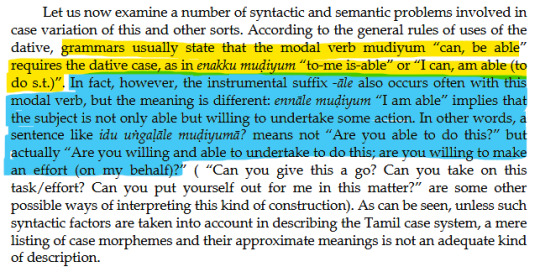
On the "extended dative", which connotates something like "on the behalf of" or "for the sake of":


I especially find his analysis of the suffix -kitte fascinating, because Schiffman uncovers a potential case ending in Spoken Tamil that connotes something about the directness or indirectness of an action, separate from the politeness with which the person is speaking to their interlocutor.

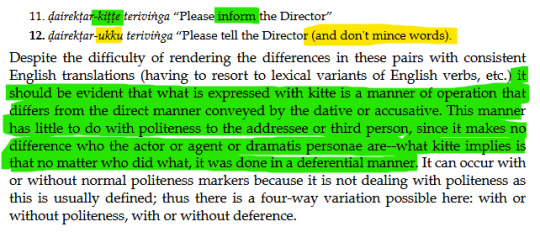
Not to blather on but here's a direct comparison with Finnish, which as stated earlier has 15 cases and not the 7-8 commonly stated of Tamil:
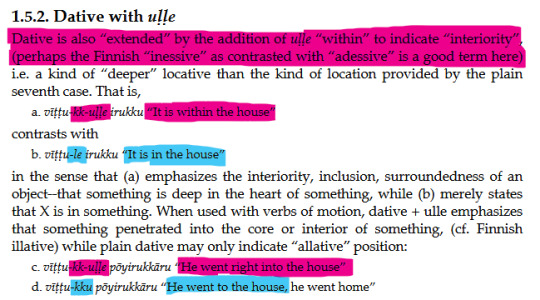
What Schiffman seems to have discovered is that ST, and LT too for that matter, has used existing case endings and in some cases seemingly invented new ones to connote shades of meaning that are lost by the conventional scholar's understanding of Tamil cases. And rather than land on a specific number of cases, he instead says the following, which I find a fascinating concept:
The Tamil Case System is a kind of continuum or polarity, with the “true” case-like morphemes found at one end of the continuum, with less case-like but still bound morphemes next, followed by the commonly recognized postpositions, then finally nominal and verbal expressions that are synonymous with postpositions but not usually recognized as such at the other extreme. This results in a kind of “dendritic” system, with most, but not all, 8 of the basic case nodes capable of being extended in various directions, sometimes overlapping with others, to produce a thicket of branches. The overlap, of course, results from the fact that some postpositions can occur after more than one case, usually with a slight difference in meaning, so that an either-or taxonomy simply does not capture the whole picture.
How many cases does Tamil have? As many as its speakers want, I guess.
60 notes
·
View notes
Text
huoooooooohhhhhhhhhhhhhhhhhh hyiiiiiii


pov presidential election results are Not Looking Good
9 notes
·
View notes
Note
out of curiosity, what are some of your favorite non-fiction books?
I really enjoyed Michel Pastoureau's book series on the history of different colors — he dives deep into how European history, material culture and philosophy affect our perception of such a basic concept.

Umberto Eco’s Vértigo (The Infinity of lists) and On Ugliness
I love the mythology series by russian publishing house MIF. They select the authors that expand on the history of mythological systems, the transition through time and modern interpretations. The titles are clickbaitey, but the books so far are definitely not just a surface scratching lists of characters. So far I’ve read Alexandra Barkova’s The Slavic myths, Joshua Frydman’s The Japanese myths, Natalia Osoianu’s The Romanian myths and Vladimir Petrukhin’s The Karelo-Finnish myths (and other works, he is amazing). Also, just look at the covers — it’s like a box of candy and I’m a sucker for a good book design.

Have read Lucy Worsley’s If walls could talk — a book following the history of English house (and way of life) from room to room — recently and enjoyed it quite a lot.
120 notes
·
View notes
Text
European history is not white


Someone commented this to a post I reblogged, which message is basically "we shouldn't venerate the Dead White Man HistoryTM and we should elevate other history too, but we still need to learn Dead White Man HistoryTM to understand the world today". It's basically a response to the attitude you sometimes come across in the internet that sees learning about those Dead White MenTM as not worth our time. And this person, who seems to be following this blog because they responded to my reblog, takes it as a personal attack against all white Europeans. For some reason. Well I take these comments as a personal attack against historical understanding.
Firstly, the post clearly didn't say you shouldn't venerate any European history, because not all European history is Dead White Man HistoryTM. Obviously this person thinks European history is white, which is not true, but surely, surely, they know it's not all men? Secondly, what is "west culture"? When did it start? There is not one western culture, not one European culture. The first concept of some shared Europeanness was the Christendom in Middle Ages, but it was not exactly the same as we think of Europe today, because it did not include the pagan areas, but it included a lot of Levant and parts of Central Asia, where there were large Christian areas. And Europe was not "very white" nor was the Christendom. The more modern concept of West was cooked in tandem with race and whiteness during colonial era and Enlightenment, around 17th to 18th centuries. And Europe was certainly not very white then. The western world also includes a lot of colonized areas, so that's obviously not white history. Thirdly, implying that asking white people to apologize for European history (which no one did ask) is as ridiculous as asking black people for African history is... a choice. Black people do exist in a lot of other places than Africa, which white people should be the ones apologizing for, and really white people also have a lot to answer for about African history. Lastly, if you think the quote "anyone who thinks those dead white guys are aspirational is a white supremacist" means you as an European are demanded to apologize for your existence, maybe - as we say in Finland - that dog yelps, which the stick clanks. (I'm sorry I think I'm the funniest person in the world when I poorly translate Finnish sayings into English.)
The thing is, there is no point in European history, when Europe was white, for three reasons. 1) Whiteness was invented in 17th century and is an arbitrary concept that has changed it's meaning through time. 2) Whichever standard you use, historical or current, Europe still has never been all or overwhelmingly white, because whiteness is defined as the in-group of colonialists, and there has always been the internal Other too. In fact the racial hierarchy requires an internal Other. 3) People have always moved around a lot. The Eurasian steppe and the Mediterranean Sea have always been very important routes of migration and trade. I've been meaning to make a post proving exactly that to people like this, since as I've gathered my collection of primary images of clothing, I've also gathered quite a lot of European primary images showing non-white people, so I will use this opportunity to write that post.
So let's start from the beginning. Were the original inhabitants of Europe white? Of course not. The original humans had dark skin so obviously first Europeans had dark skin. Whenever new DNA evidence of dark skinned early Europeans come out (like this study), the inevitable right-wing backlash that follows is so interesting to me. Like what did you think? Do you still believe the racist 17th century theories that white people and people of colour are literally different species? I'm sure these people will implode when they learn that studies (e.g. this) suggest in fact only 10 000 years ago Europeans had dark skin, and even just 5 000 years ago, when Egypt (an many others) was already doing it's civilization thing, Europeans had brown skin (another source). According to the widely accepted theory, around that time 5 000 years ago the Proto-Indo-European language developed in the Pontic-Caspian steppe, which extends from Eastern Europe to Central Asia. These Proto-Indo-Europeans first migrated to Anatolia and then to Europe and Asia. Were they white? Well, they were probably not light skinned (probably had brown skin like the other people living in Europe around that time), the Asian branch of Indo-European peoples (Persians, most Afghans, Bengalis, most Indians, etc.) are certainly not considered white today and a lot of the people today living in that area are Turkic and Mongolic people, who are also not considered white. I think this highlights how nonsensical the concept of race is, but I don't think Proto-Indo-Europeans would have been considered white with any standard.
Around Bronze Age light skin became common among the people in Europe, while in East Asia it had become wide spread earlier. This does not however mark the point when "Europe became white". During the Bronze Age there was a lot of migration back and forth in the Eurasian steppe, and the early civilizations around Mediterranean did a lot of trade between Europe, Africa and Asia, which always means also people settling in different places to establish trading posts and intermarrying. There were several imperial powers that also stretched to multiple continents, like the briefly lived Macedonian Empire that stretched from Greece to Himalayas and Phoenicians from Levant, who didn't built an empire but settled in North Africa, Sicily and Iberia. In Iron Age the Carthaginian Empire, descendants of Phoenician settlers in current Tunisia, build an Empire that spanned most of the western Mediterranean coast. Their army occupying that area included among others Italic people, Gauls, Britons, Greeks and Amazigh people.
Iron Age also of course saw the rise of the Roman Republic, and later empire, but it was preceded by Etruscans, who populated Tuscan, and possibly preceded the Indo-European presence. However, weather through trade and migration with other Mediterraneans or the continuing presence of darker skin tones of the early Europeans, their art quite often depicts darker skin tones too, like seen below in first two images. Roman Empire at it's height spanned from Babylonia to the British Isles. They recruited soldiers from all provinces and intentionally used stationed them in different areas so they wouldn't be too sympathetic to possible rebels or neighboring enemies. Historical sources mention black Nubian soldiers in British Isles for example. They also built a lot of infrastructure around the empire to ensure protection and easy transportation through trade routes inside the empire. During this time Jewish groups also migrated from Levant to both North-Africa and Europe. Rome even had non-European emperors, like Septimius Severus who originated from Levant and was Punic (descendants of Phoenicians) from his father's side, and who was depicted with darker skin (third picture below). Various ethnicities with differing skin tones are represented all over Roman art, like in the fourth picture below from hunting lodge in Sicily.

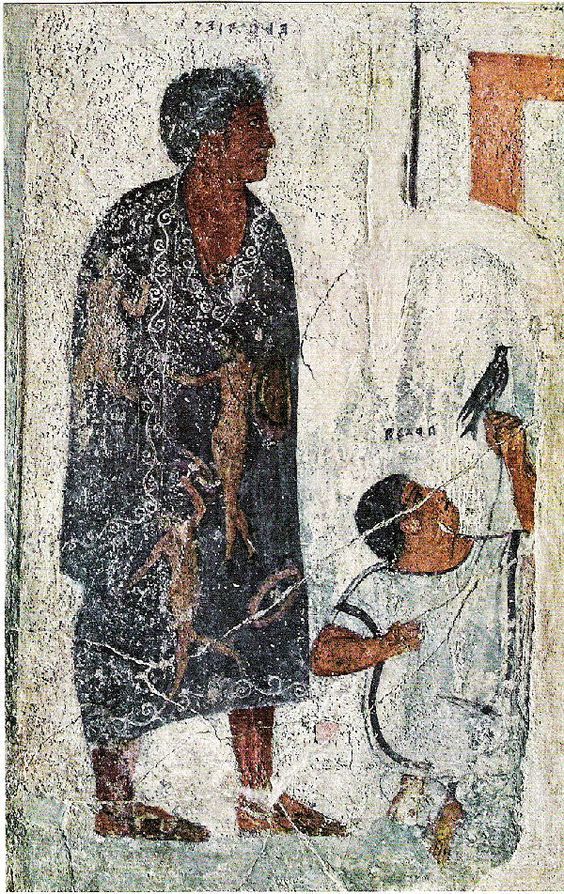
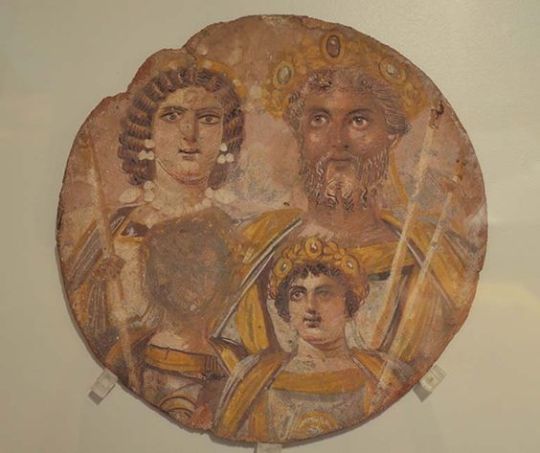

Eurasian steppe continued to be important source of migration and trade between Europe and Asia. Scythians, Iranic nomadic people, were important for facilitating the trade between East Asia and Europe through the silk road during the Iron Age. They controlled large parts of Eastern Europe ruling over Slavic people and later assimilating to the various Slavic groups after loosing their political standing. Other Iranic steppe nomads, connected to Scythian culture also populated the Eurasian steppe during and after Scythia. During the Migration Period, which happened around and after the time of Western Rome, even more different groups migrated to Europe through the steppe. Huns arrived from east to the Volga region by mid-4th century, and they likely came from the eastern parts of the steppe from Mongolian area. Their origins are unclear and they were either Mongolic, Turkic or Iranic origin, possibly some mix of them. Primary descriptions of them suggests facial features common in East Asia. They were possibly the nomadic steppe people known as Xiongnu in China, which was significant in East and Central Asia from 3rd century BCE to 2nd century CE until they moved towards west. Between 4th and 6th centuries they dominated Eastern and Central Europe and raided Roman Empire contributing to the fall of Western Rome.
After disintegration of the Hun Empire, the Huns assimilated likely to the Turkic arrivals of the second wave of the Migration Period. Turkic people originate likely in southern Siberia and in later Migration period they controlled much of the Eurasian steppe and migrated to Eastern Europe too. A Turkic Avar Khagenate (nation led by a khan) controlled much of Eastern Europe from 6th to 8th century until they were assimilated to the conquering Franks and Bulgars (another Turkic people). The Bulgars established the Bulgarian Empire, which lasted from 7th to 11th in the Balkans. The Bulgars eventually adopted the language and culture of the local Southern Slavic people. The second wave of Migration Period also saw the Moor conquest of Iberia and Sicily. Moors were not a single ethnic group but Arab and various Amazigh Muslims. Their presence in the Iberian peninsula lasted from 8th to 15th century and they controlled Sicily from 9th to 11th century until the Norman conquest. During the Norman rule though, the various religious and ethnic groups (which also included Greeks and Italic people) continued to live in relative harmony and the North-African Muslim presence continued till 13th century. Let's be clear that the Northern Europe was also not white. Vikings also got their hands into the second wave migration action and traveled widely to east and west. Viking crews were not exclusively Scandinavians, but recruited along their travels various other people, as DNA evidence proves. They also traded with Byzantium (when they weren't raiding it) and Turkic people, intermarried and bought slaves, some of which were not white or European. A Muslim traveler even wrote one of the most important accounts of Vikings when encountering them in Volga.
By this point it should already be clear that Medieval Europe was neither white, but there's more. Romani people, who originate from India and speak Indo-Aryan language, arrived around 12th century to Balkans. They continued to migrate through Europe, by 14th century they were in Italy, by 15th century in Germany and by 16h century in Britain and Sweden. Another wave of Romani migration from Persia through North-Africa, arrived in Europe around 15th century. Then there's the Mongol Empire. In 13th century they ruled very briefly a massive portion of the whole Eurasian continent, including the Eastern Europe. After reaching it's largest extent, it quickly disintegrated. The Eurasian Steppe became the Golden Horde, but lost most of the Eastern-Europe, except Pontic-Caspian Steppe. They ruled over Slavs, Circissians, Turkic groups and Finno-Ugric groups till early 15th century. The Mongolian rulers assimilated to the Turkic people, who had been the previous rulers in most of the steppe. These Turkic people of the Golden Horde came to be known as Tatars. Golden Horde eventually split into several Tatar khagenates in 15th century, when the khagenates, except the Crimean Khagenate, were conquered by the Tsardom of Moscovy. Crimean Khagenate was annexed by the Russian Empire in 1783. Crusades were a movement from Europe to Levant, but they also meant intermarriage in the the Crusader kingdoms especially between the European and Levant Christians, and some movement back and froth between these kingdoms and Europe, trade and a lot of movement back after the Crusader kingdoms were defeated in 13th century. Generally too trade across the Mediterranean sea was extensive and led to migration and intermarriage.
And here's some example of people of colour in Medieval European art, shown as part of the majority white European societies. First is from a 15th century French manuscript depicting Burgundy court with dark skin courtier and lady in waiting. Second one is from a Flemish manuscript from 15th century of courtiers, including a black courtier, going for a hunt. Third is a 15th century Venetian gondolier with dark skin.

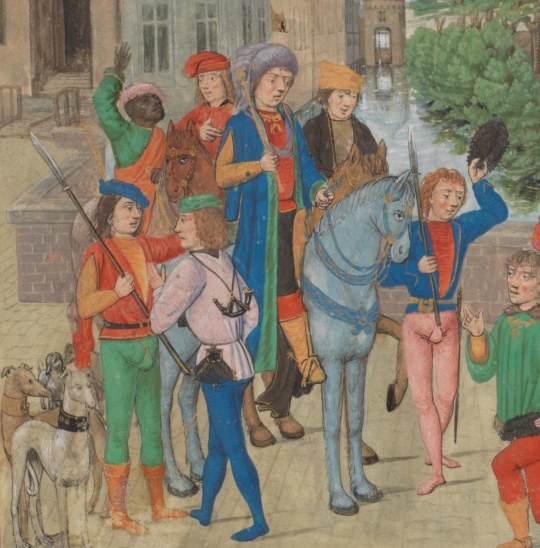
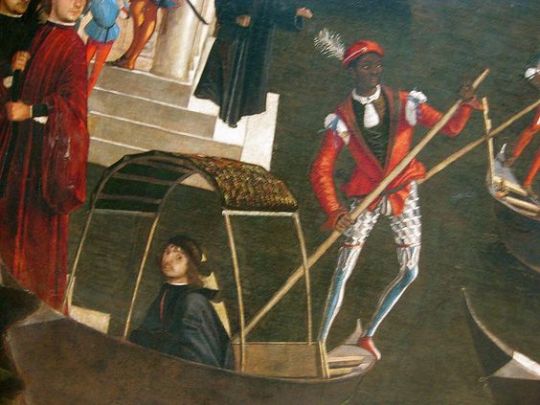
In Renaissance Era Europe was only increasing it's trade and therefore had even more connections outside Europe. The first picture below is Lisbon, which had strong trade relationship with Africa, depicted in late 16th century. People with darker skin tones were part all classes. Second image is an Italian portrait of probably a seamstress from 16th century. Third one is a portrait of one of the personal guards of the Holy Roman Emperor. Fourth image is a portrait of Alessandro de' Medici, duke of Florence, who was noted for his brown complexion, and the modern scholarly theory is that his mother was a (likely brown) Italian peasant woman.
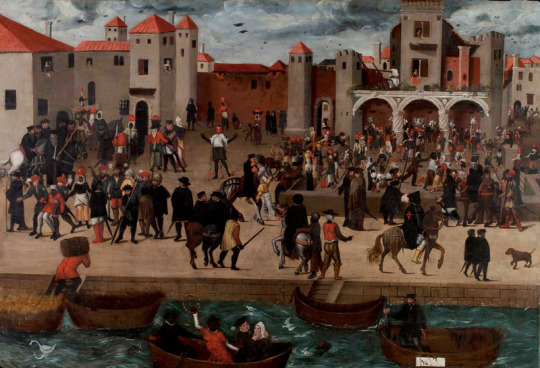
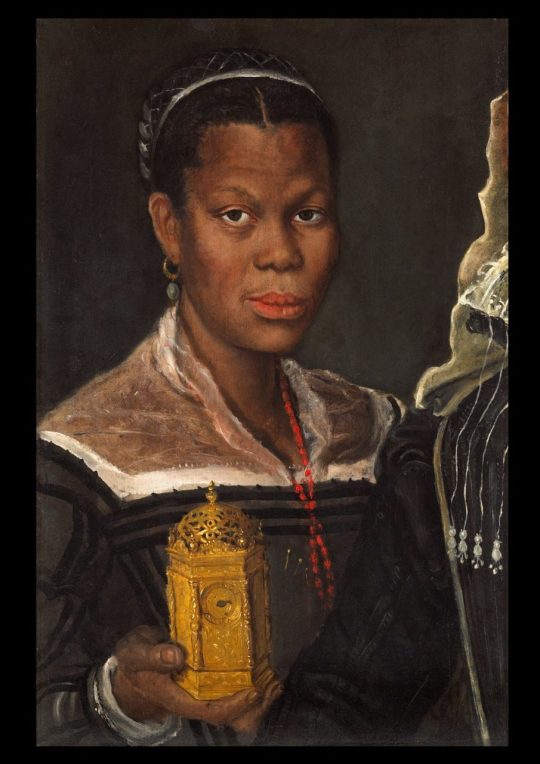
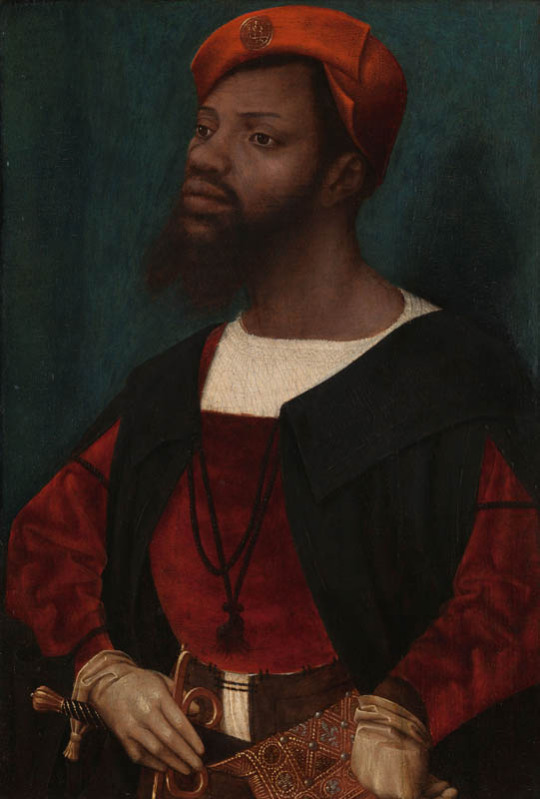

Colonialism begun in the Renaissance Era, but the wide spread colonial extraction and slavery really got going in the 17th century. Racial hierarchy was developed initially to justify the trans-Atlantic slave trade specifically. That's why the early racial essentialism was mostly focused on establishing differences between white Europeans and black Africans. Whiteness was the default, many theories believed humans were originally white and non-whites "degenerated" either through their lives (some believed dark skin was basically a tan or a desease and that everyone was born white) or through history. Originally white people included West-Asians, some Central-Asians, some North-Africans and even sometimes Indigenous Americans in addition to Europeans. The category of white inevitably shrank as more justifications for atrocities of the ever expanding colonial exploitation were required. The colonial exploitation facilitated development of capitalism and the industrial revolution, which led to extreme class inequality and worsening poverty in the European colonial powers. This eventually became an issue for the beneficiaries of colonialism as worker movements and socialism were suddenly very appealing to the working class.
So what did the ruling classes do? Shrink whiteness and give white working classes and middle classes justifications to oppress others. Jews and Roma people had long been common scapegoats and targets of oppression. Their oppression was updated to the modern era and racial categories were built for that purpose. The colonial powers had practiced in their own neighborhoods before starting their colonial projects in earnest and many of those European proto-colonies were developed to the modern colonial model and justified the same way. In 19th century, when racial pseudoscience was reaching it's peak, Slavs, others in Balkan, the Irish (more broadly Celts), Sámi (who had lost their white card very early), Finns, Southern Italians, the Spanish, the Southern French and Greeks all were considered at least not fully white. The Southern Europeans and many Slavs were not even colonized (at least in the modern sense, though with some cases like Greeks it's more complicated than that), but they looked too much and were culturally too similar to other non-white Mediterraneans, and they were generally quite poor. In many of these cases, like Italians, the French and Slavs, it was primarily others belonging in the same group, who were making them into second class citizens. All this is to highlight how very malleable the concept of race is and that it's not at all easy to define the race of historical people.
However, even if we would go with the racial categories of today, Europe was still far from being all white in this period. You had Roma, who certainly are not included in whiteness today, and European Jews, whose whiteness is very conditional, descendants of Moors in Southern Europe and Tatars and Turks in Eastern Europe and Turkey, which today is often not thought of as part of Europe, but historically certainly was. And then colonialism brought even more people into Europe forcibly, in search of work because their home was destroyed or for diplomatic and business reasons. There were then even more people of colour, but they were more segregated from the white society. Black slaves and servants are very much represented in European art from 17th century onward, but these were not the only roles non-white people in Europe were in, which I will use these examples to show. First is a Flemish portrait of Congo's Emissary, Dom Miguel de Castro, 1643. Second is a 1650 portrait of a Moorish Spanish man Juan de Pareja, who was enslaved by the artist as artisanal assistant, but was freed and became a successful artist himself. Third is a 1768 portrait of Ignatius Sancho, a British-African writer and abolitionist, who had escaped slavery as a 20-year-old. Fourth painting is from 1778 of Dido Elizabeth Belle, a British gentlewoman born to a slave mother who was recognized as a legitimate daughter by her father, and her cousin. The fifth portrait is of an unknown woman by (probably) a Swiss painter from late 18th century. Sixth is a 1760s Italian portrait of a young black man.

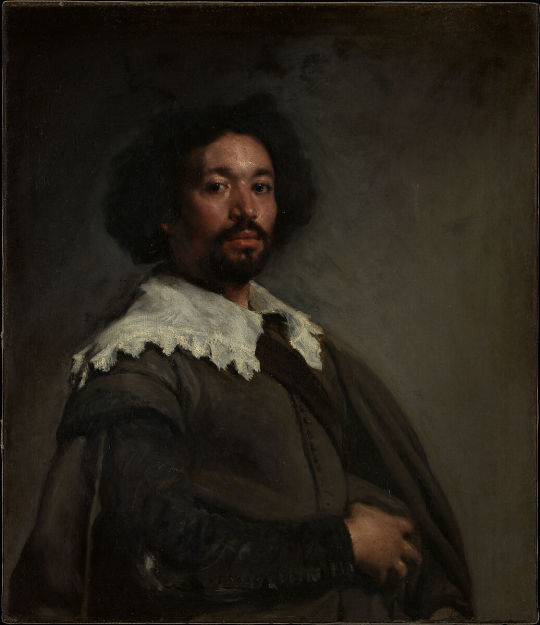
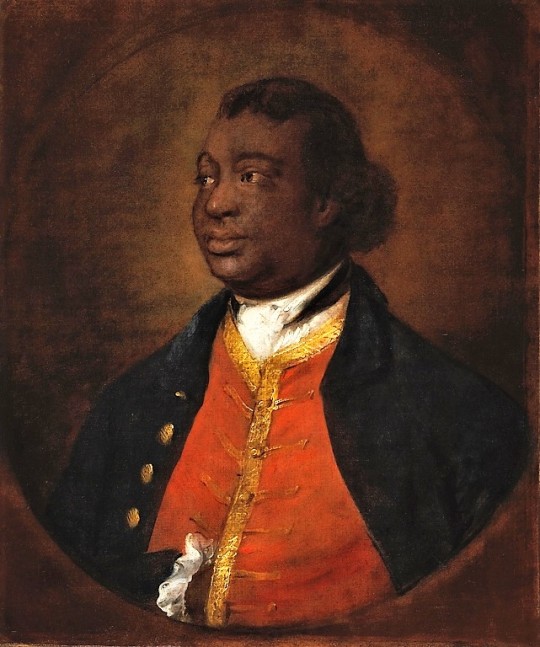
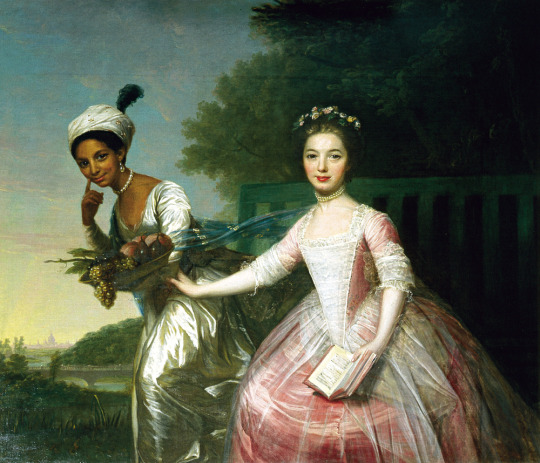
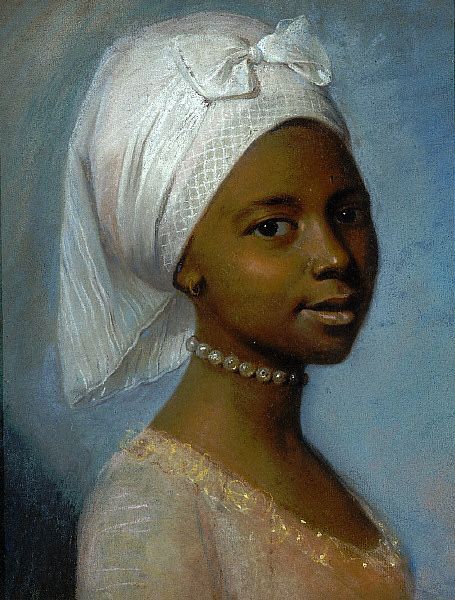
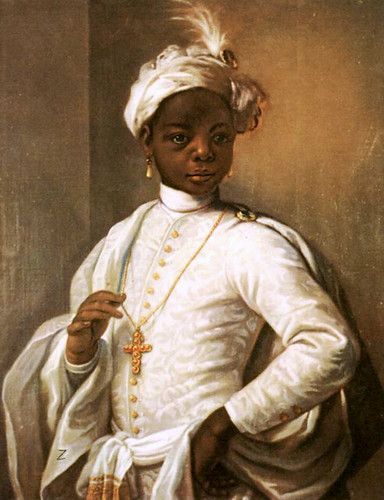
In late 18th century England abolished slavery in British Isles first, then in early 19th century in the whole British Empire, thanks to the continuous campaign of free Black people and some white allies, notably Quakers. Around the same time slavery was abolished in France (briefly till Napoleon got to power) after the French revolution. This meant there were a lot more free black people in Europe after that. In 18th century the Europeans, British especially, were colonizing Asia as much they could, which meant that in 19th century there started to also be a lot more Asian, especially Indian people in Europe. First picture below is of Thomas Alexander Dumas, who was son of a black slave woman and a white noble French man and became a general in the French revolutionary army. His son was one of the most well-known French authors, Alexander Dumas, who wrote The Count of Monte Cristo and The Three Musketeers. Second portrait is of Jean-Baptiste Belley, a Senegalese former slave, who became French revolutionary politician. Third portrait is from 1810 of Dean Mahomed, an Indian-British entrepreneur, who established the first Indian restaurant in London. Forth is Arab-Javanese Romantic painter Saleh Syarif Bustaman, who spend years in Europe. Fifth is a 1862 photo of Sara Forbes Bonnetta, originally named Aina, princess of Edbago clan of Yoruba, who was captured into slavery as a child, but later freed and made Queen Victoria's ward and goddaughter. She married a Nigerian businessman, naval officer and statesman, James Pinson Labulo Davies (sixth picture).
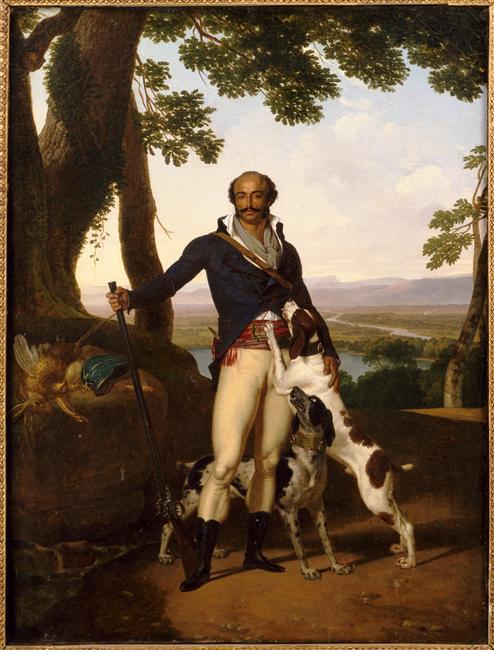



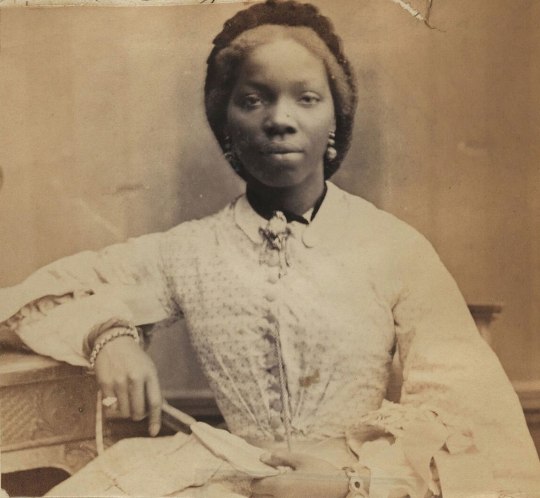

So any guesses on at what point was that "very white Europe" when the "west culture" begun? It kinda seems to me that it never actually existed.
#history#poc history#black history#historical art#european history#history of race#colonialism#racism#slavery#painting#photograph
201 notes
·
View notes
Text
Results and analysis of this survey I did few months ago about the perception of Eurovision among young people. I know some people were interested so here it is. I couldn't post it sooner so it wouldn't look like I plagarised a random tumblr account so! Here we go. These are more or less directly translated from the research part of my thesis.
I apologize for any mistakes made since the whole thing, including graphs and tables were originally in croatian, and given tumblr format, it's bound to be messy.
The age of the participants was 18+ due to ethical rules, but most of the them are young people in the age bracket 18-35, precisely because the opinion of young people who cannot physically be present at the event itself is often ignored. The research question was "How do young people perceive Eurovision?", and the goal of the research was "To see what kind of view young people have of Eurovision, and what they consider its most important aspect, entertainment, politics or something else entirely."
Considering all of the above, the participants, who were 559 in total, were asked 22 questions through an anonymous online survey that was conducted in the period from March 21, 2024 to April 5, 2024.
From this, three hypotheses were distinguished before the actual research;
H1: Young people view Eurovision more politically than the older generation.
H2: Young people focus more on the performance and the message of the song than on the quality of the vocals.
H3: Young people think that Eurovision is a competition for the audience, not for the jury, and that the winner should be decided by the audience.
For the sake of transparency, most of the data is expressed in percentages and due to the amount of data, some of the questions are additionally crossed referenced and compared to see how they interact.

Graph 1 shows the age of the participants, which was important for determining the dominant age group. As can be seen on the graph, the largest number of respondents are aged 18-24, followed by 25-35, which corresponds to the aim of the research, as the focus was on the opinion of young people about Eurovision.

Graph 2 shows the gender of the participants, in which it can be seen that the largest number of them were women, over 65%. The data on the second largest group of respondents was unexpected, as over 20% of them declared themselves non-binary. This percentage was certainly contributed by the fact that the respondents received the survey via social networks, especially Tumblr, and considering that the topic is Eurovision, which is known for its openness towards the LGBT community. Men made up less than 10% of respondents, and the Other category referred to respondents who either did not want to share information about their gender identity, or their gender identity was not part of the first three categories.

Table 2(changed it to graph here because of tumblr) shows the countries from which the participants come from, and this answer to this question was open, that is, the participants had to write it themselves. To make it easier to navigate through so many different answers, they are presented in a table.
Table 2 shows that the majority of respondents are from the UK, Finland, and Germany. USA and Croatia. The number of responses from Finnish respondents is at least partly caused by last year's competition, where their representative was the crowd favorite. As for the large number of respondents from the USA, it can be assumed that with the inclusion of voices from the rest of the world, they became more active in the Eurovision virtual spaces last year.

Graph 3 shows the answers to the question "Are you part of the LGBT community", where participants could answer with "Yes", "No" or "Other" in case they did not want to declare themselves.
As shown in Graph 3, it can be seen that the percentage of respondents who are part of the LGBT community is also influenced by the collection of data from social networks where the LGBT identity is more pronounced, but it does not deviate much from the Eurovision name "Queer Olympics". This is also important information that can be obtained through an anonymous survey, as most of the previous research was conducted on respondents from live events, so this question was often avoided due to doubts about the sincerity of the answers. Thus, over 80% of respondents identify themselves as part of the LGBT community, which confirms previous research on the importance of connecting with other queer people through ESC as an event.

Graph 4 shows the answers to the question "Do you watch Eurovision" where there were three answers; "Yes", "No" and "Ocassionally".
According to Graph 4, it can be seen that the majority of respondents (over 70%) watch Eurovision regularly, while another 23% watch it occasionally, probably depending on external factors. Only 6% of respondents do not watch Eurovision at all, which is logical in the context of solving the questionnaire about Eurovision itself.

Graph 5 shows the three associations the participants had to Eurovision. Sets of three words each were divided into positive, negative and mixed associations, and for the sake of simplicity of presentation, thus entered in the graph. It should be noted here that the majority of respondents still have positive associations related to Eurovision, while slightly less than 17% have negative associations, and only slightly less than 2% have mixed associations. It is also important to note that each association was separated before sorting, so it is possible that someone had both positive and negative associations that were added to one or the other, but if the separate ones were not in a mixed category, then they were not added.

The full question for participants was to choose from 30 songs in the last 10 years (with 3 answers offered for each year) who they thought won that year. The real winners each year are highlighted in yellow in Table 3.
Regarding the recognition of winners in the last ten years, Table 3 shows that the majority of respondents knew the winners. However, it should be taken into account that these are respondents who mostly follow Eurovision regularly, and for this reason every artist who was not the winner that year and has more than 10% of the votes is relevant. This group includes Zlata Ognevich from 2013, Dami Im from 2016, but also Sergey Lazarev from 2016 (most likely because the predictions were in favor of Russia that year, and Austria was the original audience favorite), Kristian Kostov from 2017, and Käärijä from It will be in 2023. Therefore, it is important to look at this table with the predictions of the winners for each year, and to compare it with the difference between the votes of the jury and the audience, but every passing of 10% in this survey is significant.

The full question for the participants was; Did the backstage content (i.e. preparties, interviews, socializing between contestants that is published on social networks) influence their decision on who they voted for. Answers were offered on a scale from "It had a lot of influence" to "It had no influence at all".
Considering the fact that Eurovision organizers invest a lot of money and time in the organization of content even before the competition itself, especially in their famous preparties, it is relevant to see that according to Graph 6, as many as 37% of respondents admit that watching this content directly affects who they vote for, although it is to a lesser extent. Of course, it should be taken into account that 31% of respondents are not influenced by this content at all in their decision to vote, but if we add neutral respondents and respondents who were not influenced by this content, we get about 53%. On the other hand, the total number of respondents on whom the content had an impact in general is about 47%, which means that the content is still quite relevant and good marketing for Eurovision itself, but also for the contestants.

The question for the participants was what they perceive as the main point of Eurovision. Answers to this question were offered, but respondents could also add their own answer. The responses "A mixture of more than the above" and "Political/economic gain" were written by respondents.
According to graph 7, most participants believe that the main point of Eurovision is entertainment (36.31%), and almost the same number think that the main point is for the competing countries to unite around something fun through the competition. While only about 8% of people think that the political and economic part is the main point of the competition. Considering the age of the respondents and the fact that many say that Eurovision is a very political event, it seems that most still focus on the main point as a kind of entertainment and unity between countries.

Graph 8 shows the answers to the question "What should voting look like?".
The answers confirm one of the set hypotheses, which is that young people think that deciding on the Eurovision song should have primarily been the decision of the viewers who vote, and not the jury. It should be noted that the answers offered to this question were "Only viewers should be able to vote", "It should be half-and-half", "There are different winners for the jury and the audience" and "I don't know/Neutral/On my own". In other words, the answer that both of them vote, but that the votes of the audience have more weight, is the answer that 20.57% of respondents wrote under "Other" in different forms.

The question shown in Graph 9 was what participants think the current Eurovision slogan is. There the answer was open and they had to write it themselves. Graph 9 shows that the majority of participants know the Eurovision slogan, which coincides with the number of respondents who regularly watch ESC. It is important to note that for the first time the slogan is the same as last year, which certainly contributed to the respondents' accurate recall of the slogan, which was the goal of the organizers when they decided on this move.

The question presented in Graph 10 logically follows on from the previous one, where participants had to answer which slogan they think best describes the idea/meaning of Eurovision as a brand. In Graph 10, it can be seen that the majority of respondents also agree that the current, permanent slogan of the ESC is the most suitable for representing Eurovision as a brand. Here the answers were already offered, and the slogans offered to the respondents were those that had been used in the last ten years, most of which alluded in some way to community. "United by music", however, incorporates both music and togetherness in one slogan, and it seems that it is precisely because of this that it is memorable and easy to associate with Eurovision.

In Graph 11, participants were supposed to express their general opinion about ESC. Here the answers were also offered on a scale from "Very positive" to "Very negative".
In Graph 11, it can be seen that the opinion of the respondents is mostly positive, over 50%, and even 22% of them are neutral about the view of ESC. Given that these are respondents who mostly watch Eurovision regularly, the assumption would be that their opinions are more polarized, either to one side or to the other. However, through the questionnaire, it can be seen that respondents gravitate more towards "predominantly positive/negative" when the more accurate answer would probably be "strongly positive/negative" when comparing their answers with the other associations and answers provided. When the divisions are narrowed down to positive/negative/neutral, the ratio of positive view of ESC is even more prevalent, and despite a lot of talk about political aspects and contest rigging, less than 1% of respondents have a very negative opinion about Eurovision.

In this question, participants had to answer what they consider the most important part of the contestant's performance, which is shown in Graph 12. This question touches on another hypothesis, and from the answers received, that hypothesis can neither be fully confirmed nor rejected. The answers confirm that the performance is a very important aspect, as predicted in the hypothesis, but the second most important aspect for the respondents is the melody of the song itself, which we assumed would not be so important and that the message of the song would be more important, which is not the case with the respondents . It should also be noted that the answers to this question were again only semi-structured and the respondents could write their answers. "A mixture of all of the above" and "Be a special feeling" are answers that were not offered, but were included by the respondents themselves as their answers.

Graph 13 shows participants' answers to the question of whether they prefer competitors from neighboring countries. Answers were offered on a scale from "Yes, I strongly prefer songs from neighboring countries" to "No, I never have a preference for songs from neighboring countries".
This question was relevant due to the media's frequent reference to the preferential voting of certain countries for their neighbors. The respondents show that this is a rare case, and that only about 11% of them had preferences for neighboring countries. This also coincides with the selection of the song for its performance, as most of the similarities between neighboring countries come through the melody of the song.

This question showed for how many participants the contestant changed their view of the country they represented, which is shown in Graph 14. The offered answers to this question were only "Yes" or "No". There are several studies on Eurovision as a mega-event and an event through which better diplomatic relations can be achieved. (Zahavi, Ariely, 2024) It can be seen that here the distribution of influence is more balanced, but almost 60% of respondents, most of whom regularly watch the ESC claim that their view of at least one of the countries has changed by watching their performance at the ESC. In other words, the large investment of countries in their representatives has its purpose.

This question is a continuation of the previous one, that is, if one of the contestants changed their opinion about a country, was it a positive or negative change of view. Answers are offered on a scale from "Strongly positive" to "Strongly negative".
As can be seen from the presentation on Graph 15, if the 42% of respondents who were not influenced by the competitors are put aside, the positive influence prevails again. However, it is important for which countries there are which impressions, for which reason these data were compared with the following question, which was: "If this influenced your opinion about a certain country, for which country was it?" Then we divided the countries that were repeated the most and compared the positive/negative impressions. For the sake of clarity, strongly positive/negative and mostly positive/negative are added together in the same column and put in percentages.

In Table 5, the data on the positive/negative opinion and on the countries for which the participants changed their opinion are cross-referenced. From Table 5, it can be seen that Slovenia and Finland are the countries most often cited by respondents as those whose opinion has changed to a positive one. Also, a large number of respondents left the country for which they had a positive change of opinion unspecified. It is important to add the popularity of Finnish and Slovenian competitors from last year to the very context of the analysis. As for the negative impression, it is evident that Israel is in the lead, even though 4.29% is still much lower than 11.45%, which is the biggest positive impression, that is still important data. It is an important fact that despite the large investment, Israel has such a negative level of impression, especially as the main sponsors of the ESC. However, this can be added to the hypothesis that young people still see Eurovision through its political aspect, and that the recent conflict between Israel and Palestine has only increased this negative view.

Graph 16 shows the answers to the question of how many respondents discovered a performer through Eurovision, and that they continued to listen to him after Eurovision. From Graph 16, it is clear that this was exactly the case for over 90% of respondents. The answers offered were only "Yes" or "No".

Table 6 shows which performers the participants continued to listen to after Eurovision. The answer to this question was free, and most respondents answered with more than one contractor.
These answers also confirm that positive impressions about the country are closely related to its representatives and fans who follow them even after Eurovision. Here again, you can see the huge influence of the Finnish and Slovenian representatives from last year, who greatly raised positive impressions for those countries. Måneskin also greatly raised the rating of Italy after his victory in 2021, but it should be taken into account that after a few years, fans of a band or an artist have a smaller association of them with that country. It should also be noted that many of the aforementioned artists are not winners, and many of them were not even in the top 3 at Eurovision itself. From this, it can be concluded that there is a difference in what is considered a Eurovision song, and what the interviewees consider in their everyday life to be the songs they want to listen to.

Graph 17 shows the answers to the question about what the participants think about the direct passage of the "Big Five" to the finals. Answers were offered on a scale from "Strongly positive" to "Strongly negative".
From the answers shown in Graph 17, when separating the answers into only positive and negative views about having a direct passage to the final, it is evident that about 55% of respondents have a negative opinion about it, and slightly less than 40% a neutral opinion. This confirms again that the majority of young people do not have a positive opinion about the privileged position of some countries, which is a direct influence of politics.

Graph 18 shows the answers to the question "Do you plan to boycott watching Eurovision this year" with the answers offered "Yes", "No" and "Maybe/I haven't decided yet." Here, of course, it was meant boycotting specifically because of the participation of Israel and the current conflict between them and Palestine.
The question about boycotting Eurovision was deliberately put last, so as not to affect associations and positive and negative impressions. The question could have been more properly asked in the form "Are you planning to watch Eurovision this year" as the word boycotting still came out as suggestive. As can be seen from the responses from Graph 18, more than 50% of the respondents said that they would boycott Eurovision, which does not fit in with the majority's positive impressions about the event itself, which we analyzed in the previous responses. In any case, this supports the hypothesis that young people view the ESC more politically than the older generation, as the majority of younger respondents were more inclined to answer the question about boycotting in the affirmative.
However, it was interesting to compare some of the responses with the respondents' decision to boycott. That is why in Table 5 we have combined the data of the General opinion on Eurovision presented in Graph 11 and the data from Graph 18 on boycotting watching the ESC.

Table 8 shows that almost 30% of participants with a positive opinion of Eurovision planned to boycott watching because of Israel's participation, while only slightly less than 10% of those with a negative opinion planned the same. It can be seen that this trend continues with other answers as well. The fact is that a positive opinion about Eurovision prevails among respondents, but almost 10% more of those with a positive opinion plan to boycott than those who plan to watch. For the same reason, data on respondents' viewing consistency were combined with their response on boycotting in Table 9.

Table 10 compares the age of the participants with their answers about boycotting. The percentages were taken from the number of each of the age groups, and not the total sum, as there were the most respondents in the first two groups, that is, from 18-24 and from 25-35. Nevertheless, this table is important to us because we can see a reconfirmation of our hypothesis that young people look at Eurovision more politically than the older generation.
Now, this is of course, very, very brief look into the whole thesis, without literature citation to back it up and without discussion because it's already way too long. That said, I don't wish to imply that people who said they are boycotting on the survey lied about it, I just thought it was an important look into why someone with generally good opinion on the event would decide to boycott and if age had anything to do with it.
If anyone has any questions, regardless if it has to do with smth being translated confusingly or about the data itself, please let me know! Also consider that this data, while it was overwhelming done via tumblr, also took participants via facebook and instagram and ofc people I know irl and people those people know, so this is not only tumblr mentality reflected either. Hope this satisfied everyone's curiosity!
#eurovision#survey#käärijä#joker out#putting it in the tags if anyone who saw it there the first time wants to read it#y'all!!! I am graduating on the 10th I am shaking fr
71 notes
·
View notes
Text

For the past ~11 years I’ve tried to heal a trauma & get seal of approval by being a musician, artist & part of rock band. I’ve sacrified my personal life, relationships, money, time, youth, mental & physical health for the ultimate goal to prove everyone something that doesn’t even matter in the end. To anyone who knows me personally this might be already familiar but I’ve tried to let go of my toxic ego lately. That evil on my shoulder has been a great guide towards the impossible but the flipside has been anything but good. I’ve gone through hell too many times with that unwanted friend & I don’t wanna deal with that anymore. Last 3,5 years we’ve played nearly 300 shows worldwide, recorded & released two (#1 🇫🇮) studio albums, played the biggest rockfestivals on a planet, charted on Billboard, won 6 finnish grammys, peaked 6. on Eurovision Song Contest finals. All of this has been more than 14 yo Joel could have ever imagined. But it all came with a price. Last spring we had massive touring schedule: 60 shows non stop in EU, UK, US & Japan. That was our 3rd year in a row with super heavy touring schedule. After the tours we started to think about our future and came up with the idea of a break. It felt scary but it was the best decision this band has ever made. We’re starting our UK + Ireland tour next week with @lacunacoil & playing the Final Emotions Tour in Finland after that with packed clubs all around the country. I recommend to get your tickets right now if you wanna see us. Finnish national broadcasting company Yle has followed us for the past 2 years non stop. The TV documentary ’After Dark Side’ will be broadcasted on TV2 in December 2024. ”Mikään ei kestä ikuisesti, ei edes Oulun pojan erektio.” - V. Laihiala 2005. This is not the end my friends. Kippis ja kulaus. Nähdään helvetissä!
53 notes
·
View notes
Note
I’m curious, what is the reason a production will give a Christine actress a blonde/different colored wig? I know smaller productions often have a blonde Christine (I think at least) but like- London for example, I thought they had a few Christine’s with a blonde wig, I assumed because the actress was a blonde but I swear there were some blonde Christine’s that also had a dark wig as well. Is there any reason for this? Or is it just random?
I the earliest days of POTO there was a will to adapt the 'Degas' wig to whoever played Christine and Meg. Whereas all three original Christines in West End followed the Sarah Brightmanesque look with big brown curls, they did feature Patti Cohenour on Broadway with a much lighter brown wig, to adapt to her colouring. It wasn't blonde, but it was a light auburn / reddish brown:
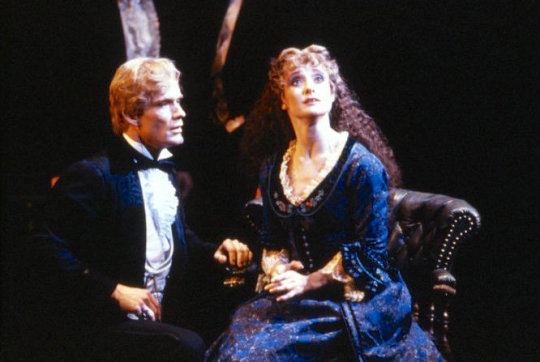
For the original Toronto production they also changed Susan Cuthberg's wig from brown to blonde during her run, making her the first blonde ALW Christine out there. This too was due to it being closer to her own colouring:

Equally, Janet Devenish started out with a very red Meg wig in West End. Later in her run it was changed to a blonder one. It's the blonde look that's stuck on Meg, but interestingly she was a redhead first!

A final example from early POTO days is that original Australian Meg, Sharon Millerchip, started out as a blonde, but it was decided that a brunette wig looked better on her. Once again to adapt to the actress' natural colourings.

But later in the 1990s the general formula stuck. Christine as a brunette, Meg as a blonde. A handful of Christines in West End was featured with auburn wig to match their own colouring, and one or two Megs got a brown wig, but they were definitely the exception rather than the rule. Especially in the US and the World Tour the Christines has worn a general dark brown wig completely unrelated to what hair colour they have in real life. This is what is generally done for the replica production, as the design indicates brown curls, but with some exceptions here and there.
With the first ever non-replica production, in Hungary 2003, their Christines partly wore their own hair, braided, with extensions in the back. This meant that a variety of colours has been seen there: Vanilla blonde, darker blonde, auburn, brunette. Here's barbara Fonyo (auburn), Renata Krassy (blonde) and Andrea Maho (brunette):
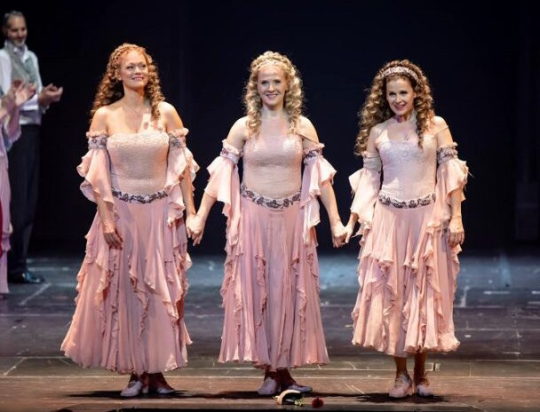
The non-replica productions that followed chose different strategies:
The 2008 Polish production emulated the 2004 movie, with curly brown wigs
The 2013 Restaged Tour did a less curly, general brown wig
The 2014 Estonian production featured their Christines with their actual hair colour (one brunette, one blonde)
The 2014 Czech production stuck fairly close to the original design, with long brown curly wigs,
The 2015 Finnish/Swedish production tried out different shades of red; first strawberry blonde, then flaming red.
The 2015 Romanian production and later Norwegian/Greek/Tour version went blonde. The Romanian production featured the actress' own hair, while the others has done wigs. But there's been different shades of blonde, different lengths and different curls. Gaston Leroux has been mentioned as inspiration.
The 2017 Serbian production also featured their Christine with their respective hair, which gave one blonde and one brunette.
Ditto for the 2019 Bulgarian production, ranging from light brown to black hair.
The 2020 Swedish production first went red for Christine. I have read they thought it was never done before and that's why they wanted to try it out (but as seen above, the Finnish/Swedish production beat them to it). When a new principal Christine was cast they gave her a blonde wig, to better match her colouring.
The 2022 Sydney Harbour production did fairly classic brown curly wigs.
The 2023 new Romanian production also feature Christine with her own hair - like the original Romanian production, and incidentally the same actress. But it looks like there's a bit of extensions going on as well.
Last, but not least, the 2023 Mediterranean production premiering in Italy did somewhere between honey blonde and auburn.
So in large, a non-brown Christine wig seems to be a way of adapting the hair to the actress - whether a wig is in use or not. In some cases it's also a way of actively differentiate the look from Maria Bjørnson's original design (as well as the iconic Mary Philbin look).
In replica production the 'wildest' things they did in the 1990s and early 2000s was auburn Christine wigs, and primarily in West End. But in the later 2000s more variations started to appear. The very light brown wigs of Janine Kitzen in Stuttgart and Robyn North in West End comes to mind, and Anne Görner's fairly redhead wig. Then Harriet Jones' first auburn red wig in West End, and them going all blonde on Emmi Christensson. Again the overall strategy seems to be to match the actress' own colours and the wig. Left: Anne Görner in Essen, and right: Emmi Christensson in West End.

In recent years there's also been a will to adapt the texture of the curls. From recent West End examples there is Lucy St Louis, Beatrice Penny-Touré, Paige Blankson and Chumisa Dornford-May with afro-textured hair. Ditto for Emilie Kouatchou on Broadway. Here's Lucy St Louis with Killian Donnelly:
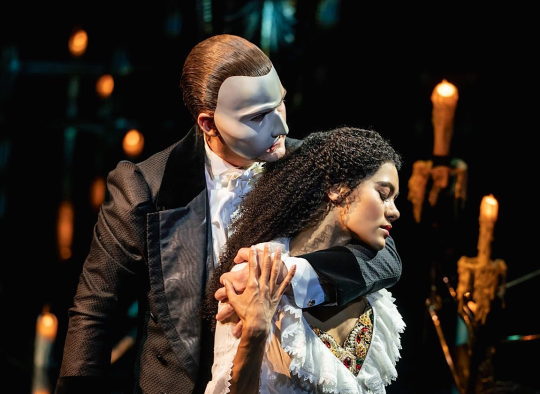
And then the recent wig change for Eve Shanu-Wilson in West End, which is meant to closer reflect on her heritage. Though the Phantom historian in me also thinks it brilliantly reflects on the 1990s West End wigs, so I'm doubly happy...

So yeah. Usually the variations in wig colour and curls is due to a will to reflect on who the actress is and how she looks in real life. But the wig is of course also a tool to create a certain look for a certain role. Which means that every wig is an interpretation, and a negotiation between wanted look and the many possibilities for adaption.
#christine wig#phantom of the opera#christine daae#costume nerding#not tagging them all#maria bjørnson#non replica
63 notes
·
View notes